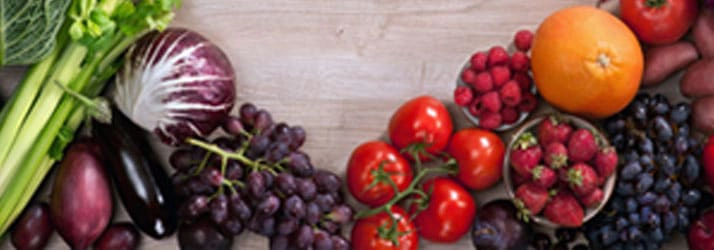Today we're talkin' PROTEIN in Lafayette LA!

Touchy subject when you are suggesting plant-based protein alternatives to people who were raised on red-meat and poultry. Our goal isn't to convert anyone into a vegetarian or vegan, just to create an awareness of other protein rich foods that come from plants. For assistance with this topic, I turn to Plant-passionate Expert, Kris Carr.
The belief that we need enormous amounts of protein to be healthy and strong in Lafayette LA is one of the biggest myths in America. In fact, overdosing on protein is one of the reasons we've become so unhealthy. Studies show that as protein consumption goes up, so do the rates of chronic disease, i.e. INFLAMMATION. Why? Well, when we consume more protein than we need the body produces a ton of acid to break this stuff down. What thrives in an acidic environment? Chronic aches, pains, diseases and cancer.
So, how much protein do you really need?
The USDA's recommended daily allowance is about 0.36 gram of protein for every pound of body weight (so, at 130 pounds, you'd need about 47 grams of protein daily).
Please note: If you're an athlete trying to build muscle, are pregnant or lactating, or are under physical stress, use 0.45 when calculating protein needs (so, at 130 pounds, you'd need about 59 grams of protein daily). Reality check: The average American adult consumes between 100 and 120 grams of protein every day. Not only is that nearly two to three times what we need, it comes mostly from high-fat animal products.
So, if we replace meat with plants, what does a typical day's meals look like? (You may be asking…)
Here's how a moderately active adult who weighs 140 pounds could meet their protein needs (50 grams per day):
- Breakfast: 12 ounces green juice = 2 grams protein, ½ avocado on 1 piece Ezekiel toast = 8 grams protein
- Snack: 1 cup raspberries and ¼ cup raw almonds = 9 grams protein
- Lunch: Large green salad with ½ cup black beans, ¼ cup raw sunflower seeds with olive oil and brown rice vinegar dressing = 15 grams protein
- Snack: 10 rice crackers and raw veggies dipped in ½ cup hummus = 13 grams protein
- Dinner: Broccoli stir-fry served over ½ cup brown rice = 6 grams protein
- Snack: Green apple with chamomile tea = 1 gram protein
TOTAL: 54 grams protein
So clearly, if you're eating a well-balanced plant-based diet-meaning you're consuming a wide variety of high-quality foods, like vegetables, greens, sprouts, legumes, beans, nuts, grains, and so on-then you will certainly meet your protein needs. Even the higher protein needs of pregnant and breast-feeding women and athletes can easily be met just by eating more of the good stuff.
Do I need to be concerned about eating complete proteins?
Proteins are long strings of amino acids. There are twenty different amino acids you need for good health, but our bodies can only make eleven of them. The remaining nine are referred to as essential amino acids. Because we can't make them, it is essential for us to get them from our diet. Foods that contain all nine essential aminos are known as complete proteins, although they are not necessarily better protein sources.
While animal flesh is a complete protein, it's also "complete" with potentially harmful saturated fat and cholesterol, plus hormones, antibiotics, etc. And unlike their plant-based counterparts, they lack phytonutrients, water, antioxidants, enzymes, and fiber. And did you know that many plants have complete proteins? Can you say quinoa, soy products, buckwheat, and hemp seeds? Other plant proteins are only slightly incomplete, so as long as you're eating a variety of them you've got a complete protein powerhouse. You don't even have to eat them all at the same meal or even on the same day.
Animal-Based Protein: The Bigger Picture
Whether or not a particular food is healthy for us doesn't solely stem from its nutritional value. It's also about how your dinner got to your plate. When evaluating the health consequences of animal products we must also consider the way the critters were raised and treated. Compassion aside, this is about your well-being.
How an animal is cared for from birth to slaughter truly, madly, deeply affects your body. Unhealthy animals create unhealthy food. The unsanitary and inhumane practices of factory farms threaten our food supply. Would you knowingly drink from a polluted well? We must remember that we humans are at the tippy-top of the food chain. This means that we eat everything that the critter below us ate and below them ate and so on.
What if you want to include animal products in your diet?
It's your choice and we totally support you! My advice: keep it to a minimum (two or three times per week), as a garnish or side dish, and make the best selections. According to the American Dietetic Association, a portion of meat shouldn't be larger than a deck of cards, or the palm of your hand (about 3 ounces).
In addition, do your best to say "no way" to factory-farm products. Instead, look for the Certified Humane Seal, which is the gold standard in farming. As for seafood, Food and Water Watch is a terrific resource to learn what seafood products are safest and, therefore, healthiest. Unfortunately, farm-raised fish often experience similar confinement and health issues. As for wild fish, our oceans aren't what they used to be and as a result, high levels of mercury (especially in deep-sea fish) and other heavy metals are abundant.
A Place to Start: Your Shopping Guide to Stocking up on
Some Really Great Alternative Protein Sources!
Tofu-Extra Firm 3 oz =9 grams
Raw Almonds ¼ cup =8 grams
Raw Sunflower Seeds ¼ cup =7 grams
Raw Chopped Broccoli 1 cup =6 grams
Chia Seeds 2 Tbsp =6 grams
Raw Kale Chopped 2 cups =4.5 grams
This week's recipe (so delicious - you won't miss the meat!):
Spaghetti Primavera
Serves 4
- 2 tablespoons olive oil
- 1 small Spanish onion, diced
- 1 handful of cremini mushrooms, sliced
- 2 cloves garlic, chopped
- 1 small green zucchini, diced
- 1 small yellow squash, diced
- 1/2 green bell pepper, diced
- 1 cup kale finely chopped
- 1 can of organic red kidney beans, drained & rinsed
- 1 cup chopped broccoli
- 1 24 ounce can of organic crushed tomatoes
- 1 Splash of red wine
- 1 teaspoon of organic Italian seasoning
- 1 package of brown rice (or quinoa) spaghetti
- Salt and pepper to taste
Heat the oil in a skillet and sauté the onions, mushrooms and garlic until soft. Add the zucchini, squash, bell pepper and red beans, season with salt and pepper and continue cooking for 5-10 minutes. Meanwhile boil a large pot of water to cook the spaghetti (be sure to heavily salt the pasta water before placing the pasta in the pot! It not only flavors the pasta but prevents sticking!) Add the crushed tomatoes, wine, Italian seasoning and salt and pepper to taste and bring to boil, then simmer for 10 more minutes. Finally, add your kale and broccoli to the sauce, stir to combine and toss the sauce with the cooked, drained pasta and serve.
By Francesca Marino D.C.
OFFICE HOURS
Monday
8:30am - 5:30pm
Tuesday
8:30am - 5:30pm
Wednesday
Closed
Thursday
8:30am - 5:30pm
Friday
7:30am - 11:30am
Saturday & Sunday
Closed
Open for Massage & Treatment
During Business Hours
Modern Chiropractic
318 Bertrand Dr #101
Lafayette, LA 70506



